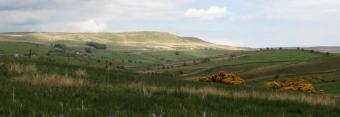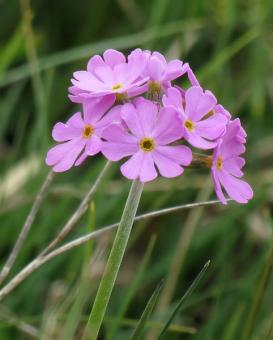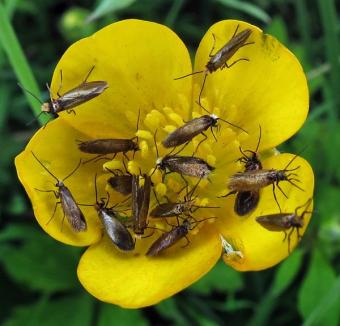 View From Augill Pasture
View From Augill PastureToday was a day for the botanists. A fair amount of time was spent on our knees, lenses at the ready to have a close look at the plants.
We timed today's trip to Asby Inrakes (and Outrakes - but I don't think we entered this field), a small site west of Kirkby Stephen, hoping to see the Small White Orchid. The place wasn't immediately recognisable to John; when he previously visited this rough pasture it had been covered in a range of orchids that weren’t evident today. Birds Eye Primrose Despite our outriders crisscrossing the tussocky ground there was no sign of the Small White Orchid. Once again we commented on plants being late this year.
Birds Eye Primrose Despite our outriders crisscrossing the tussocky ground there was no sign of the Small White Orchid. Once again we commented on plants being late this year.
However there were other flowers to attract our attention. The Birds-eye Primrose were lovely, a few Early Purple Orchids were still vibrant and there was plenty of Water Avens. There were groups of Marsh Valerian, and we were able to identify the difference between the male and female plants, the latter having both a smaller flower head and notably smaller florets.
Amongst the 38 species recorded in flower other notable recordings were Common Milkwort, Bitter Vetch and Lousewort.
As we were leaving there were a couple of other people hunting for the Small White Orchid. A friendly wave goodbye from them almost caused us to bail out of the van in excitement, but we will have to return another time if we want to see this flower.
We then had a relatively short journey, via the toilets in Brough, to Augill Pasture. This is a small site with a fair amount of history. An Attractive Buttercup To Micropterix Calthella A medieval track, a Roman sentry post, a lead smelting mill from 1820’s and a modern day protest that prevented the A66 being driven through it, resulting in it becoming a Plantlife site.
An Attractive Buttercup To Micropterix Calthella A medieval track, a Roman sentry post, a lead smelting mill from 1820’s and a modern day protest that prevented the A66 being driven through it, resulting in it becoming a Plantlife site.
It is managed by Cumbria Wildlife Trust and is a rare example of an unimproved upland grassland. It is on a small hill, with woodland on the slopes and open grassland on the brow. There seems to be a greater proportion of herbs than grass, which promise a great display later in the year. The primroses were still in flower, as were the bluebells, but there was also signs of the summer flowers starting with Globe Flower and Heath Spotted-orchid.
Overhead were Oystercatcher, Curlew and Lapwing, with a bird count totalling 21. Six Spot Burnet Moth CaterpillarWe had read that Adder’s Tongue-fern grew here, so it was again eyes down looking for a tiny green leaf. Never had so many young Common Twayblade plants caused so much disappointment as they continually raised our hopes in search for this elusive fern! Next year…
Six Spot Burnet Moth CaterpillarWe had read that Adder’s Tongue-fern grew here, so it was again eyes down looking for a tiny green leaf. Never had so many young Common Twayblade plants caused so much disappointment as they continually raised our hopes in search for this elusive fern! Next year…
We found the rare white form of Bugle, a few diminutive Frog Orchids and a pleasant clump of Herb Paris. In total 68 species of plant in flower and 8 ferns were recorded. We found a striking yellow and black caterpillar which turns out to be a Six-spot burnet moth. At Augill Bridge we saw a Roe Deer as we arrived and half the group were entertained by a Red Squirrel with reports of somersaults, waving and general showing off!
It is a long journey to reach these parts so it was pleasing that many flowers were seen in the verges en route and that we were accompanied by Goldfinches and Pied Wagtails as we drove home along Mallerstang. Chips at Bizzies in Skipton was our final stop, with our final leg timed perfectly to avoid road closures at Crosshills by seconds.
Julia
